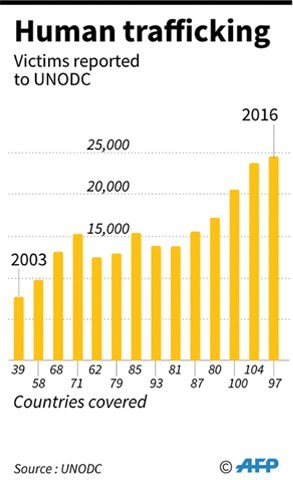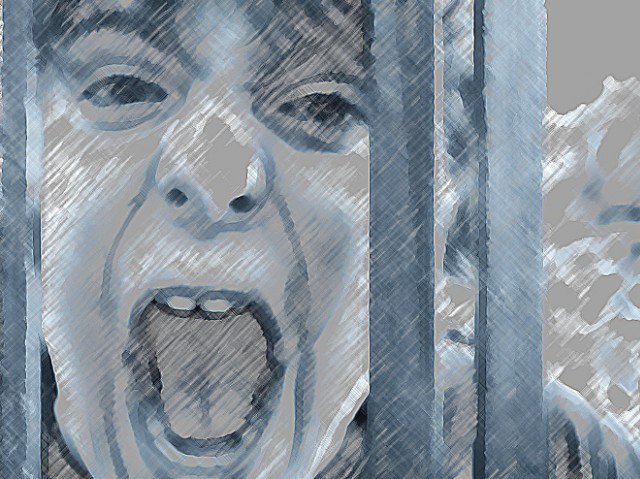Nearly a third of human trafficking victims are children; The ‘Global Report on Trafficking in Persons 2018’ from the UN Office on Drugs and Crime draws on information from 142 countries, examining trafficking trends and patterns.
Herald Report
 United Nations: Trafficking victims from South Asian countries are detected in many parts of Europe, according to a new UN report that said human trafficking has taken “horrific dimensions” with children accounting for a third of those being trafficked.
United Nations: Trafficking victims from South Asian countries are detected in many parts of Europe, according to a new UN report that said human trafficking has taken “horrific dimensions” with children accounting for a third of those being trafficked.
The ‘Global Report on Trafficking in Persons 2018’ from the UN Office on Drugs and Crime (UNODC) draws on information from 142 countries, examining trafficking trends and patterns. The report said human trafficking is taking on “horrific dimensions”, with sexual exploitation of victims the main driver. Children now account for 30% of those being trafficked, and far more girls are detected than boys.
Victims from South Asia (and South-West Asia) are also detected in many parts of Western and Southern Europe. They account for about 5% of the total detected victims in this sub-region.
The limited information available for Bangladesh, Maldives, Nepal and Pakistan reveals that female victims accounted for 59pc of the total detected victims. Detection of boys is limited. Overall, almost equal proportions of men, women and children are detected. Among the detected trafficking victims in 2016, 37pc are men. Nepal reports more child victims than adults.
 In Pakistan, the parliament has approved two new laws, “The Prevention of Trafficking in Persons Act 2018” and “The Prevention of Smuggling of Migrants Act 2018”. The laws safeguard the rights of victims of human trafficking and address the needs of smuggled migrants, the report notes.
In Pakistan, the parliament has approved two new laws, “The Prevention of Trafficking in Persons Act 2018” and “The Prevention of Smuggling of Migrants Act 2018”. The laws safeguard the rights of victims of human trafficking and address the needs of smuggled migrants, the report notes.
“Victims are trafficked from most South Asian countries, including Bangladesh, India, and Pakistan, and to a limited extent also from Nepal and Sri Lanka. Victims from Afghanistan have been detected in the Nordic countries, the Netherlands, and the UK,” it said.
The report further said that as an origin area for trafficking to the rest of the world, victims from South Asia have been detected in more than 40 countries around the world. The main destinations appear to be the countries of the Gulf Cooperation Council in the Middle East. To a lesser extent, victims from South Asia have been detected in Western and Southern Europe and in North America. Victims from South Asia-Bangladesh and India-have also been detected in South-East Asia.
Based on the limited information available for Bangladesh, Maldives, Nepal and Pakistan, female victims in this sub-region account for 59% of the total detected victims.
UNODC Executive Director Yury Fedotov said, “human trafficking has taken on horrific dimensions as armed groups and terrorists use it to spread fear and gain victims to offer as incentives to recruit new fighters,” citing child soldiers, forced labour and sexual slavery as examples.
While the average numbers of reported victims had fluctuated during the earlier years for which UNODC had collected data, the global trend has shown a steady increase since 2010. Asia and the Americas are the regions which have seen the largest increase in the numbers of victims detected, which may be explained by improved methods of detecting, recording and reporting data on trafficking or a real increase in the number of victims.
Most victims of trafficking detected outside their region of origin are from East Asia, followed by sub-Saharan Africa: while there has been an increase in the number of convictions for trafficking in these regions, the study concluding that large areas of impunity still exist in many Asian and African countries, and conviction rates for trafficking remain very low.
Trafficking for sexual exploitation is the most prevalent form in European countries, whilst in sub-Saharan Africa and the Middle East, forced labour is the main factor driving the illicit trade. Women and girls make up most trafficking victims worldwide: almost three-quarters of them are trafficked for sexual exploitation, and 35% (women and girls) are trafficked for forced labour.
The main focus of the report is on the impact of armed conflict on trafficking. In conflict zones, where the rule of law is weak, and civilians h ave little protection from crime, armed groups and criminals may take the opportunity to traffic them. One example given in the study is the phenomenon of girls and young women in refugee camps in the Middle East being “married off” without their consent and subjected to sexual exploitation in neighbouring countries.
ave little protection from crime, armed groups and criminals may take the opportunity to traffic them. One example given in the study is the phenomenon of girls and young women in refugee camps in the Middle East being “married off” without their consent and subjected to sexual exploitation in neighbouring countries.
Addressing human trafficking is a key part of the UN Sustainable Development Agenda, requiring member states to monitor progress in tackling the problem, and report the number of victims by sex, age and form of exploitation.
However, significant gaps in knowledge remain, with many countries in sub-Saharan Africa, South Asia and some parts of East Asia still lacking sufficient capacity to record and share data on trafficking in persons. “This report shows that we need to step up technical assistance and strengthen cooperation, to support all countries to protect victims and bring criminals to justice, and achieve the Sustainable Development Goals,” Fedotov said.
For many of the countries that recorded increasing trends, some of the institutional responses can be related to the increase. In particular, most of the increases coincided with or followed shortly after one or more of these anti-trafficking measures were introduced.
An increase in the number of victim detection can also reflect an actual increase in the severity of trafficking in persons, particularly in countries where anti-trafficking institutions and legal framework have been in place for a long time. What emerges from the analysis, however, is that when countries did not enhance their anti-trafficking actions, the number of detected victims tended to decline.
Adult women comprised nearly half of the detected victims in 2016. Men and girls were detected in similar proportions; each profile accounted for about one fifth of the detected victims. The analysis of the data on trafficking victims shows that over the last 15 years, women and girls together continued to represent more than 70pc of detected trafficking victims.
In South Asia, East Asia and the Pacific, men accounted for more than 30pc of detected victims in the same year; a significantly large share in the global total. In South Asia as well as in Central Asia, trafficking for forced labour and sexual exploitation were detected in near-equal proportions.
As for other forms of exploitation, trafficking for removal of organs remains very limited in terms of the numbers of detected victims. About 100 victims of trafficking for organ removal were detected and reported to the UNODC between 2014 and 2017.

The High Asia Herald is a member of High Asia Media Group — a window to High Asia and Central Asia

